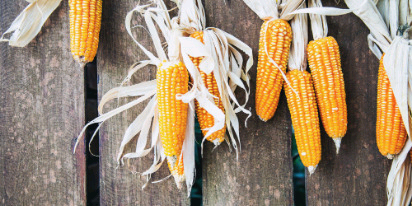
Corn, one of the world’s leading grain crops, is not only a staple food for millions but also a major component in livestock feed and numerous industrial applications.
With a variety of types to choose from, corn is a versatile and rewarding crop to grow. This guide will explore the basic requirements for growing corn, cover corn planting, the main types of corn (Dent, Flint, Sweet), and various harvesting options.
Basic Requirements for Growing Corn
Corn thrives under specific conditions and meeting these five fundamental requirements can greatly improve your crop’s success.
So here is a guide on how to grow corn.
1. Soil: The quality of the soil is fundamental for the successful growth of corn. The soil should be well-drained and fertile with a pH level between 5.8 and 7.0. Corn is a heavy feeder and requires significant nutrients, especially nitrogen. Amending the soil with organic compost or aged manure can significantly enhance its fertility and structure.
2. Sunlight: Corn is a sun-loving plant that needs full sunlight to grow effectively. This typically means at least six hours of direct sunlight each day.
3. Temperature: As a warm-season crop, corn thrives in temperatures between 60°F and 95°F. Corn requires a long, frost-free period for optimal growth and ear production.
4. Water: Although corn is relatively drought-tolerant, consistent moisture is crucial, particularly during the pollination and ear development stages. Regular watering is necessary to ensure
healthy growth, but the soil should not be oversaturated to the point where it becomes waterlogged.
5. Spacing: Corn plants should be appropriately spaced to facilitate pollination. As a wind-pollinated plant, corn does best when planted in blocks or several short rows rather than
one long row.
Generally, the plants should be spaced about 8 to 12 inches apart in rows that are 2 to 3 feet apart. Proper spacing encourages effective pollination, leading to well-filled ears of corn.
How to Plant Corn
Planting corn involves several key steps to ensure a successful crop. Here are the basic steps to plant corn:
1. Prepare the Soil: Before planting, it’s important to prepare the soil by removing any weeds and incorporating plenty of organic matter, like compost or aged manure, to increase its fertility.
Corn thrives in well-drained, fertile soil with a pH between 5.8 and 7.0.
2. Timing. When to plant corn? Planting should take place in the spring after the last frost when the soil temperature has reached at least 50°F. Corn needs a long, frost-free period to grow, and cool temperatures can stunt growth and reduce yield.
3. Plant the Seeds: Plant corn seeds about 1 to 2 inches deep and 8 to 12 inches apart. The rows should be spaced 2 to 3 feet apart to allow room for growth and ensure adequate pollination.
4. Group Planting: Because corn is wind-pollinated, it should be planted in blocks or multiple rows rather than a single long row.
This method increases the chances of successful pollination.
5. Watering: After planting, water the area thoroughly. Corn needs consistent moisture, especially during the growth and development of the kernels. The soil should always be kept moist but not waterlogged.
6. Regular Care: Monitor the corn plants regularly for any signs of pests or disease. You may also need to provide additional support to the plants as they grow to prevent them from being
damaged by strong winds.
By following these basic planting corn steps, you can set the stage for a successful corn harvest.
Main Types of Corn
The most planted types of corn include:
● Dent Corn. This is the most commonly grown type of corn and is often used for animal feed and industrial products. It’s named for the indentation (“dent”) that forms on each kernel as it dries.
● Flint Corn. Also known as Indian corn, Flint corn has a hard outer layer to protect the soft endosperm inside. It’s extremely resistant to harsh weather and poor soil conditions, making it a popular choice for areas with challenging growing conditions.
● Sweet Corn. This type of corn is what we commonly consume fresh, canned, or frozen.
It’s sweeter than other types of corn due to its high sugar content. Sweet corn should be harvested when the kernels are soft and milky, typically in late summer.
Corn Harvesting
Harvesting corn is a crucial process that depends largely on the intended use of the crop. Here are the main options for corn harvesting:
● Sweet Corn. Sweet corn is harvested when the silks are dry and brown, and the kernels are plump and emit a milky fluid when punctured. This is typically in late summer.
The harvesting window for sweet corn is relatively short, often just a week or so, as the corn rapidly loses its sweetness after peak ripeness. Regular checking of the crop is essential to ensure you harvest at the optimal time.
● Dent and Flint Corn. Unlike sweet corn, dent and flint corn are allowed to fully mature and dry out on the plant. You should harvest these types when the husks are dry and the kernels are hard, usually in early fall. These varieties are commonly used for animal feed, ground into meal, or used in industrial applications.
● Corn for Silage. If you’re growing corn for silage (a type of animal feed made by
fermenting the whole plant), you should harvest when the whole plant, including the kernels, is still green but the kernels are in the dough stage. This is typically in late summer or early fall. Silage corn is chopped into small pieces and then stored in a silo or similar structure where it ferments and is later used as livestock feed.
● Ornamental Corn or Popcorn. These types are harvested similarly to dent and flint corn. They should be allowed to dry on the plant until the kernels are hard and the husks are dry. However, if there’s a threat of bad weather, they can be harvested a bit early and allowed to finish drying in a well-ventilated area to prevent mold or other damage.
For all types of corn, once the ears are harvested, they should be stored appropriately.
Sweet corn should be eaten, canned, or frozen as soon as possible after harvesting for the best taste.
Other types should be stored in a cool, dry place.





